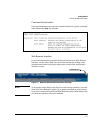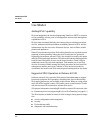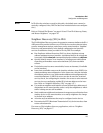
2-7
Introduction to IPv6
Configuration and Management
The next three sections outline the IPv6 features supported in software release
K.13.01.
Configuration and Management
This section outlines the configurable management features supporting IPv6
operation on your ProCurve IPv6-ready switch.
Management Features
Software release K.13.01 provides host-based IPv6 features that enable the
switches covered in this guide to be managed from an IPv6 management
station and to operate in both IPv6 and IPv4/IPv6 network environments.
Note Software release K.13.01 does not include IPv6 routing, but interoperates with
routers that support IPv6 and IPv4/IPv6 router applications.
IPv6 Addressing
The switch offers these IPv6 address configuration features:
■ SLAAC (stateless automatic address configuration)
■ DHCPv6 (stateful automatic address configuration)
■ static address configuration
SLAAC (Stateless Automatic Address Configuration)
Enabling IPv6 on a VLAN automatically enables configuration of a link-local
unicast IPv6 address on the VLAN. (No DHCPv6 server is needed.) This
address begins with the hexadecimal prefix fe80, which is prepended to the
interface identifier part of the address. (The interface identifier is generated
from the MAC address of the VLAN itself, using the 64-bit extended unique
identifier (EUI) method.) This enables the IPv6 nodes on the VLAN to
configure and manage the switch.
Enabling IPv6 address autoconfiguration on a VLAN automatically enables
automatic configuration of global unicast addresses on the VLAN. After
enabling autoconfiguration, a router advertisement (RA) containing an
assigned global address prefix must be received on the VLAN from an IPv6
router on the same VLAN. The resulting address is a combination of the prefix


















